The Dynamic Black technology adds exceptional depth to your image, smoothly adjusting the lamp output based on the brightness information of each frame. Using ISF modes, you'll be able to save your calibrated day and night mode settings for the highest viewing experience.
The fan is noisy.
Optoma HD143X is the best HD projector on the list. The model is able to deliver staggering picture quality that blows anything in the same price range out of the water. The built-in 10W audio speaker will have no issues matching that image quality with almost equally impressive sound quality.
1 year (lamp - 1 year)
DLP
3200 lumens
23000:1
16:9 native, 4:3 compatible
Full HD (1920x1080)
Screen size: 28" ~ 301"
Throw ratio: 1.47:1 - 1.62:1
+/-40° vertical
2 x HDMI, 1 x 3.5-mm audio out, 1 x 3D sync port, 1 x USB-A power out port, 1 x 12-V power port
Sealing the optical components away, this device protects them from dust, eliminating black spots and keeping the noise from reaching 35 decibels. Dissipating heat, the fully sealed housing also makes sure that the lamps last ~50,000 hours.
The remote is not especially ergonomic.
Films projected on a wall that look good even with noticeable ambient lighting coming from a device that costs just 200 quid sounds a little unrealistic, right? Well, this is very much what the Apeman LC650 is offering here. Aside from delivering detailed visuals, the SRS-endowed speakers also ensure immersive audio.
1 year (lamp - 1 year)
LCD
6000 lumens
5000:1
16:9 native, 4:3 compatible
Full HD (1920x1080)
Screen size: 30" - 300"
+/-25° horizontal and vertical
1 x HDMI, 1 x 3.5-mm composite video/audio in, 1 x 3.5-mm audio in, 2 x USB-A ports
The carry bag that comes with the device enables convenient and safe transportation. The model increases the projected transmittance, preventing stray light from distorting the image. You can project an image from as close as ~1.5 metres.
The lamps do not last as long as advertised.
The VANKYO H470C is what low-end HD projectors should be or, at the very least, should strive towards. Despite costing practically pennies, this device can stretch the screen 250 inches without making the content look blurry and/or pixelated. Plus, it is pretty good at dissipating heat, preventing overheating.
3 years
LCD
5500 lumens
4000:1
16:9 native, 4:3 compatible
HD (1280 x 720)
Screen size: 39" - 250"
+/-15° vertical
2 x HDMI, 1 x 3.5-mm composite video/audio in, 1 x 3.5-mm audio out, 1 x USB-A port, 1 x SD card slot
While its native resolution caps at WVGA (480p), the model supports Full HD films, making them look almost as good as they should. The VGA input will let you work with legacy electronics. The SD card slot will enable you to project photos onto a sizable screen.
Some find the built-in speakers pretty shoddy.
Besides projecting a decent-looking image, the ELEPHAS GC333 doubles as a cheap toy that you can assemble and disassemble about as much as you want, figuring out how projectors work or using the device in some science experiment. It is not a bad fit for classrooms and offices though, especially as a temporary replacement.
Limited lifetime
LCD
4500 lumens
2000:1
16:9 native, 4:3 compatible
WVGA (800 x 480)
Screen size: 33" - 180"
+/-15° vertical
1 x HDMI, 1 x VGA, 1 x 3.5-mm composite video/audio in, 1 x 3.5-mm audio out, 1 x USB-A port, 1 x SD card slot
The projector can be mounted to any ceiling. It is also compatible with your average table/camera tripod. The adjustable footpad lets you easily change the projector's height to adjust your viewing experience. You can use the focus wheel to make changes to the picture's clarity.
The maximum brightness is not very impressive.
Apeman LC350 isn't that great compared to every other product on the list and ridiculously great compared to every other projector in the same price range. It is an excellent affordable business solution and a decent entry-level entertainment system.
1 year (lamp - 1 year)
LCD
3500 lumens
2000:1
16:9 native, 4:3 compatible
WVGA (800 x 480)
Screen size: 34" - 180"
+/-15° vertical
1 x HDMI, 1 x VGA, 1 x RCA video in, 2 x RCA audio in, 1 x 3.5-mm audio out, 1 x USB-A port, 1 x microSD slot
This site is a free online resource that strives to offer helpful content and comparison features to its visitors. Please be advised that the operator of this site accepts advertising compensation from certain companies that appear on the site, and such compensation impacts the location and order in which the companies (and/or their products) are presented, and in some cases may also impact the scoring that is assigned to them. The scoring that appears on this site is determined by the site operator in its sole discretion, and should NOT be relied upon for accuracy purposes. In fact, Company/product listings on this page DO NOT imply endorsement by the site operator. Except as expressly set forth in our Terms of Use, all representations and warranties regarding the information presented on this page are disclaimed. The information which appears on this site is subject to change at any time. More info
Optoma HD143X
Almost Professional
Optoma HD143X is huge. It isn't necessarily professional equipment yet but the difference is definitely not that massive. Considering the mid-range price tag, the model's performance is no joke.
The projector's biggest strength is definitely the stunning picture quality that it is able to project. There are many details here that contribute to that picture quality. First and foremost, it is the model's practically absurd 23000:1 contrast ratio. Of course, this is dynamic contrast we're talking about here.
Nevertheless, these numbers are nothing to scoff at. They show that the projector is able to deliver the blackest blacks and the whitest whites. The bright parts will be bright with a capital B and the dark parts will look remarkably dark.
Other than that, the model is able to reproduce the Rec.709 colour gamut, meaning that the colours will be looking authentic and true to the director's vision.
This is a full HD (1920 x 1080p) projector we're dealing with here, so the image will be sharp and plenty detailed too.
Of course, it isn't just about these specs. The tech that the model is packing is pretty impressive too. The Dynamic Black technology, for instance, adds exceptional depth to your image, smoothly adjusting the lamp output based on the brightness information of each frame. It is able to put that dynamic contrast ratio to good use and create the most vibrant and immersive visual experience.
Thanks to this particular tech, the bright scenes will be looking crisp and clear, all while the dark scenes will remain detailed, with deep blacks and staggering light and shade detail.

The Tech and Interfaces
The ISF modes are massive. Using this feature, you'll be able to save your calibrated day and night mode settings for the highest viewing experience.
Other than the model's tech/features, the biggest contributors are the lamp life and abundant interfaces. Able to deliver for 12,000 hours, the projector's lamp should last over 10 years (provided you aren't looking to put the projector through commercial use).
The abundant interfaces will let you connect the device to a cable box, Blu-ray player, high-end gaming PC or any current-generation console. The inputs and outputs include 2x HDMI, audio-out, 3D Sync port, 12V trigger, USB power.
In other words, Optoma HD143X is among the best HD projectors in its price range. The model is able to deliver staggering picture quality that blows anything in the same price range out of the water. The built-in 10W audio speaker will have no issues matching that image quality with almost equally impressive sound quality.
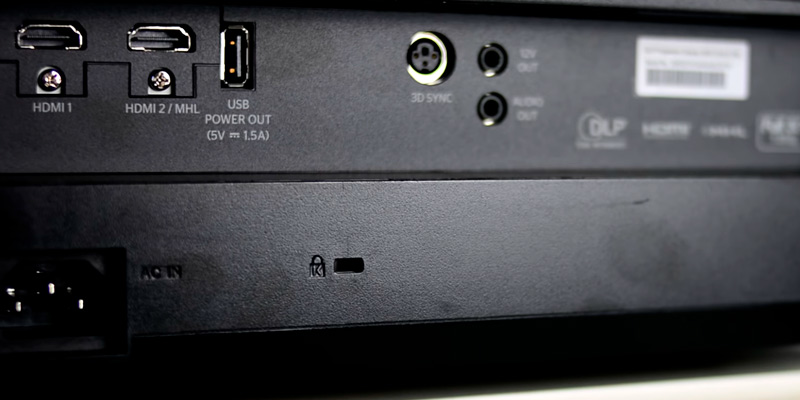
Additional Info
| Last updated price | £379.00 |
| Stock | In stock |
| ASIN | B078Y8WGV7 |

Apeman LC650
Mid-Range Specs, Low-End Price Tag
The Apeman LC650 ticks every box that mid-range HD projectors can usually cross and then some for good measure. Despite coming at ~200 quid, this is an excellent device that will be able to tussle with much more expensive models. To begin with, the projector's native resolution stretches Full HD (1920 x 1080p), meaning that the projected visuals will look sharp, crisp, and detailed. The model can even work with 4K content but, as always, the content will not look quite as brilliant as the same visuals would look on a device with a native UHD resolution.
Moving on, what usually makes or breaks most projectors is the maximum rated brightness. When we're talking about models below 3000 lumens, only complete darkness will make these projectors look good. This time though, we're working with 6000 lumens, which's quite awesome considering that this is a budget model. Reaching 6000 lumens, this device will make sure the content does not look washed-out even when there's some ambient lighting present.
Of course, the issue with low-end HD projectors seldom lies with specs. More often than not, where these products are cutting corners is in the construction department. The opposite is the case here though. No, this device is built almost like a premium model. You can play with different modes and setting as much as you want, the projector will still keep the noise levels below 35 decibels. To some extent, this is the case thanks to the dual-fan setup that also aids heat dissipation and prevents the housing from heating up during use.
Because the optical components are fully sealed, the model keeps the dust away, making sure that there are no black spots appearing on the video. Plus, with this device being as good at heat dissipation as it is, the lamps should last somewhere around 50,000 hours, an unexpected turn seeing that, again, this is a low-end model.
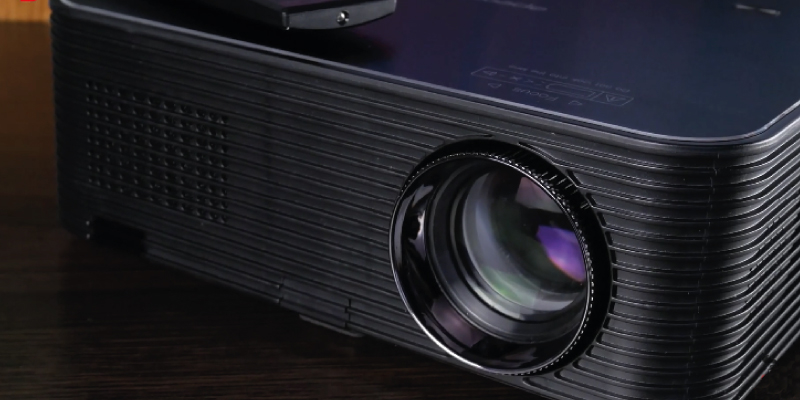
Even the Audio's Alright
Needless to say, the projector's not flawless, expecting that from a $200 device would be a little misguided. But, aside from the remote, we're fine with everything that this product's offering. Even the remote is not necessarily bad, it's just that the layout is not ergonomic and the spacing between the standard pause, play, stop, and skip button group is almost nonexistent. What is very much existent, however, is the dual-speaker setup that employs an SRS surround sound system, bringing you a pretty immersive audio experience.
Long story short, the Apeman LC650 might be the best option between budget HD projectors.
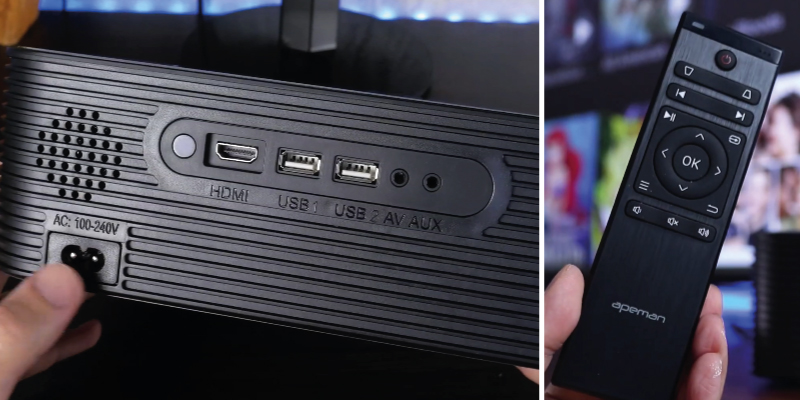
Additional Info
| Last updated price | £189.99 |
| Stock | May be out of stock |
| ASIN | B082TP8TMX |
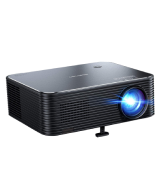
VANKYO H470C
An Appealing Bargain
The VANKYO H470C bridges the gap between cheap projectors that people play with without committing to and much less affordable mid-tier models that most customers do not find especially attractive from a price-performance standpoint. With that in mind, the best place to start is the price. With this one, you're paying 100 quid, so we'll be judging the specs while putting this low-, nay, bottom-end price into perspective first.
Does its native HD (1280 x 720p) resolution look as detailed as Full HD (1920 x 1080p)? No, not quite. Not even that close, to be honest with you. But at 100 quid? Sure, we'll take that, we'll take that in a heartbeat. Is its 4,000:1 rated contrast that great? Well, not as great as those models that double or even triple that, we can tell you that much. Spending no more than 100 pounds though? Ta, we're more than fine with that. Sure, the blacks will not be that dark and the whites will not be that bright but, generally speaking, dark scenes will look alright and the light scenes always look good regardless.
Let's pivot towards something more positive now. Increasing the projected transmittance, this device ensures that stray light is not interfering with the picture, enhancing its sharpness. Meanwhile, the integrated HiFi speakers produce adequate sound, almost matching the above-average visuals that this model projects.
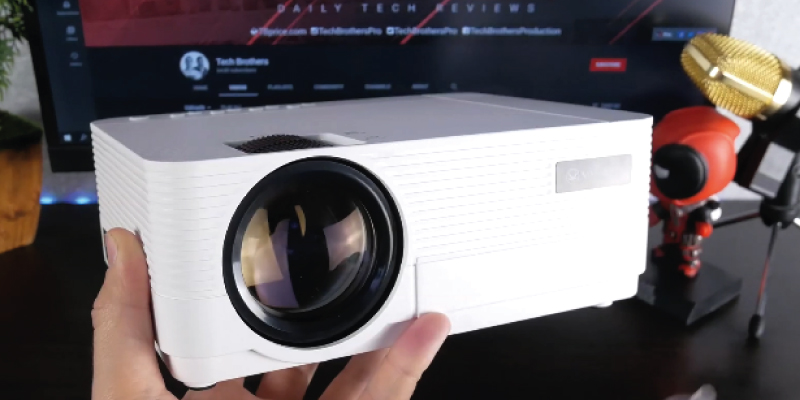
Screen Size Between ~40 and 250 Inches
The cheapest models can seldom project a sizable image. Despite sharing a price bracket with them, the VANKYO H470C can do that with relative ease. In fact, you can set the screen size anywhere between 39 and 250 inches from 4.25 and 26.5 feet respectively. 39" to 250" with projection distances between 4.27 and 26.57 feet (1.3 metres and 8 metres) respectively. While this is happening, the dual-fan system will be busy reducing noise, preventing the unit from going above 40 decibels, as well as dissipating heat, ensuring that this device does not overheat.
Sometimes, low-end HD projectors are lacking interfaces. Again though, we're not dealing with the same problem here. No, besides the standard lineup (two HDMI inputs, one 3.5-mm composite video/audio input, and one 3.5-mm audio output), this model comes outfitted with one USB-A port and an SD card slot. The one problem we have with this product that we cannot blame the price tag on is that the lamps do not last as long as advertised. Still, as egregious as it is, we can forgive the transgression and nominate the VANKYO H470C as the best HD projector below 100 quid.
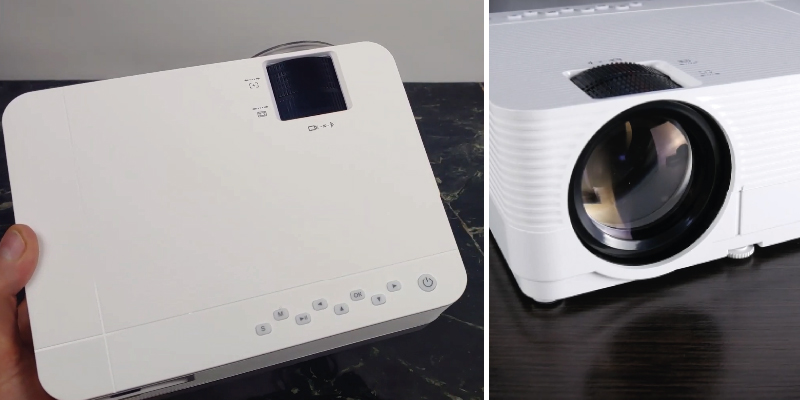
Additional Info
| Last updated price | £89.99 |
| Stock | May be out of stock |
| ASIN | B07YYYX734 |
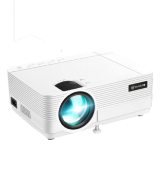
ELEPHAS GC333
An Interesting Test Subject
The ELEPHAS GC333 is not necessarily something we can easily categorise. But we have to start somewhere and, even though we've done that before, we have to start with the price once again. As much as we hate repeating ourselves, without putting the price tag into perspective, reviewing this device is pointless. At this time, this product costs less than 70 quid. On the one hand, this is quite something since you seldom see projectors this cheap. But the issue here is that the preceding model from VANKYO costs just 30 quid more and its specs are more impressive, so presuming that you can spare 70 quid on a projector, you can probably spare 30 extra quid and purchase something that can actually project an appealing-looking image, right?
When you start thinking along these lines, the model that we're working with here makes sense as a test subject, more like something that you can play with and less like something that can replace even an outdated TV set. Assuming that's what you're looking for, this model will serve wonders. With that out of the way, let's move towards its specs.
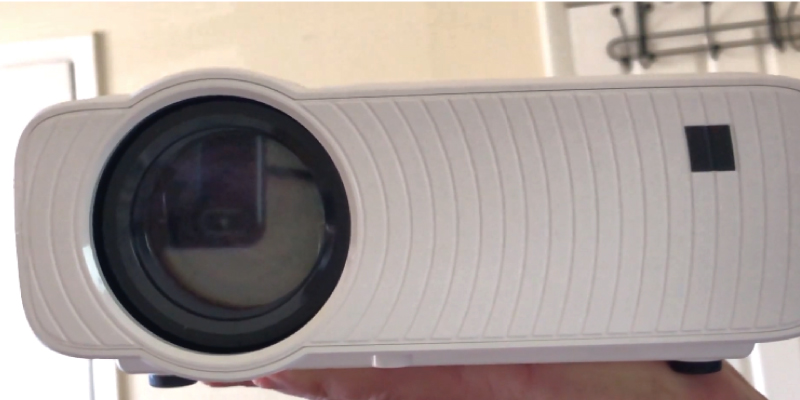
Lamps Lasting 50,000 Hours
Technically speaking, we're kind of cheating putting this device on a list with HD projectors since its native resolution is WVGA (800 x 480p), which is not the same as HD (1280 x 720p). But, because the model supports Full HD (1920 x 1080p) content, we're fine with this unit making the list, even though Full HD films will not look quite as good here as they would on a device with a native Full HD resolution. The maximum rated contrast caps at 2,000:1, which is not good, making the difference between blacks and whites not quite as massive as it should be.
On the upside, the model's rated brightness reaches 4500 lumens, meaning that even environments with some ambient light will work here. What will also work is the lamps. Because they're not supporting as much computational weight as they usually are, the lamps might just last the advertised 50,000 hours.
Testing what projectors can do is hard when you're not working with enough interfaces. This is not the case here though. On the contrary, apart from an HDMI input, one 3.5-mm composite video/audio input, and a 3.5-mm audio output, this model includes a USB-A port, an SD card slot, and even a VGA input, so you can work with legacy devices.
To rephrase the point we made earlier, the ELEPHAS GC333 is an interesting test subject that lets you play with a projector and figure out how these things work. It can also double as a replacement projector for classrooms and offices.
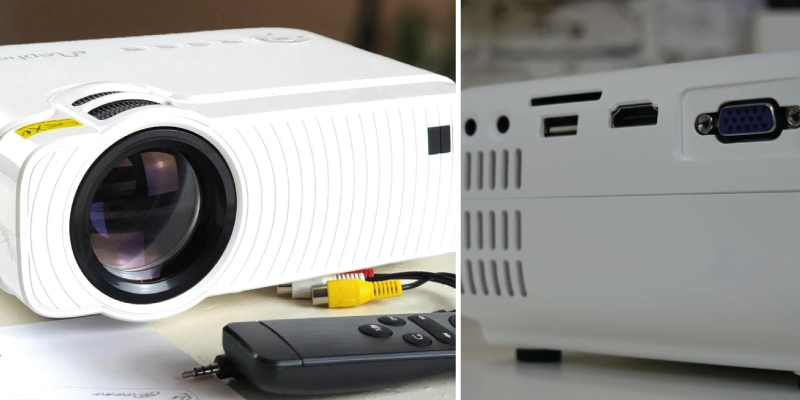
| Last updated price | £72.21 |
| Stock | In stock |
| ASIN | B07N39NDDB |
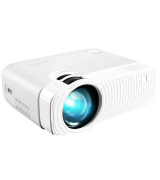
Apeman LC350
The Tightest Budget
The Apeman LC350 is the most affordable product in this lineup. Scratch that, it is the cheapest product here. "The cheapest" doesn't necessarily refer to its quality. That being said, it is definitely the least impressive prospect on the list.
At the same time, considering its ~65-quid price tag, the model is impressive, to say the least. An actual half-decent projector for money like that is an excellent deal. There's no huge brand behind the product, which is probably the only reason a deal like that is possible in the first place.
Now, let's cover the model's specs. First and foremost, its screen output will let you project any display between 34" and 180" inches. Needless to say, 180 inches is a massive display, more than enough for entertaining your friends and family.
The rated brightness is nothing to scoff at too. Able to deliver 3500 lumens, the projector will have no issues in well-lit environments. Sure, we would still recommend turning off the lights. But you will be able to recognise the image with enough daylight in the room. You'll be able to enjoy quality movie time without worrying about blinders and things like that.
The last specs here are the model's contrast ratio and resolution. These are probably the product's weakest points. As far as we're concerned, 2000:1 dynamic contrast ratio just isn't that great. The difference between blacks and whites will be solid but not solid enough.
The WVGA (800 x 480p) resolution is a far cry from high definition. It will not be able to produce detailed images. But, again, considering the price tag, these specs are more than you'd reasonably expect.

Control the Projection
Switching gears, let's move on from performance to the model's build and controls. The Apeman LC350 can be mounted to any ceiling. It is also compatible with your average table/camera tripod. You can fit it in just about any position.
The adjustable footpad lets you easily change the projector's height to adjust your viewing experience. The model's ±15° keystone correction will give you enough image positioning options. You can use the focus wheel to make changes to the picture's clarity. The dual built-in speaker system is surprisingly good. Last but not least, the projector comes with a remote controller.
Bottom line, the Apeman LC350 isn't that great compared to every other product on the list and ridiculously great compared to every other projector in the same price range. It is an excellent affordable business solution and a decent entry-level entertainment system.
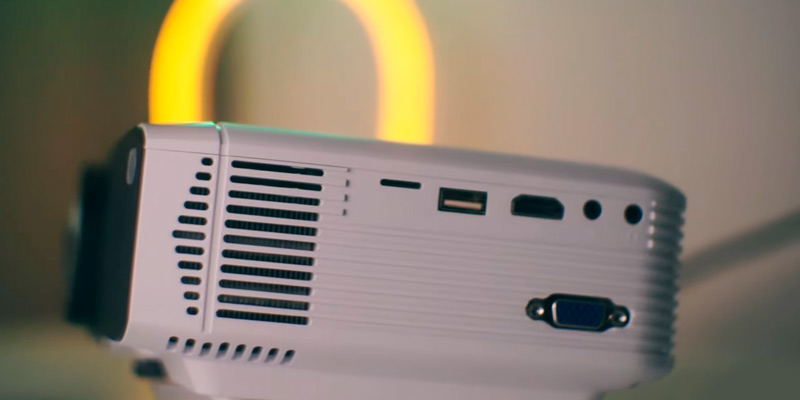
| Last updated price | £79.99 |
| Stock | May be out of stock |
| ASIN | B07HQQ749Q |
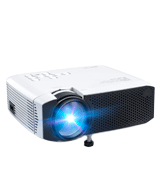
What Is an HD Projector?
HD projectors are an integral part of state-of-the-art technologies, used not only in business but also at home. These devices serve to project a high-resolution image onto the screen. There are millions of ways to employ them in everyday life, but everything depends on the specifications. Hi-end models with HD image output can be used excellently as home theatres. What’s better than meeting up with your close friends and watching your favourite films on a really large screen? Businesspersons who often make presentations can use these devices to show slides and videos to the audience. In this article, we have selected the most popular High Definition Projectors so that you could choose the one better suited for you.
To use your HD projector, you will obviously need a quality projector screen, and for those who often make various presentations, we highly recommend considering presentation remotes. And, of course, if you want to turn your home into a full-fledged cinema theatre, check the home theatre projectors!
What Features to Compare
Type
The first and foremost thing to take into account while choosing the HD projector is its type. There exist two engine types (DLP and LCD) and each has pros and cons. The DLP technology projects the image with the help of silicon reflections at numerous little mirrors. This technology provides quite a smooth image with high subpixel accuracy and without odd shadows, but the brightness is a bit lower than that of LCD models, and there is also a pixel limit. The LCD technology, in its turn, projects the image by flowing it through 3-coloured panels (red, green, and blue). The colour of the pixel is determined by the position of these panels. LCD projectors are more compact and show excellent brightness and colour saturation. On the other hand, there can eventually appear dead pixels and the image can degenerate a little.
Output Image Features
The next thing to think of is the quality of the output image, like projector brightness. Models with low brightness can correctly function only in dark rooms as distinguished from those with the colour brightness of 2000-3000 lumen and more. The aspect ratio will help understand the optimal projector application. If you are going to hold presentations, the best ratio will probably be 4:3, but if you are going to watch films, then 16:9 will be a perfect choice. It's very important to pay attention to the resolution of the projector as well. The higher it is, the more accurate and clear the image will be. To have positive user experience while watching films, the resolution should be at least Full HD.
Special Projection Aspects
Consider the special aspects of the projection. The throw and the output image size can help you set the position of the device properly. Zoom and perspective correction tools are also important and allow setting more accurate image on the screen.
Device Connectivity
Do not forget to check the available ports and plugs, which determine the connection options. The more video inputs the projector has, the more devices you will be able to connect simultaneously. Audio outputs make it possible to add the audio.
Did You Know?
You Can Make a Projector with Your Own Hands If You Want
It's nothing fancy but, as far as Do-It-Yourself projects go, it can be a lot of fun and even a bit of learning when you reach certain steps. Basically, you'll need a cardboard box big enough to put your multimedia gadget in and have some space left, a magnifying glass, some strong tape, and your smartphone or tablet (depending on where the videos you want to watch are stored).
- Take the box and cut a hole in one of its walls the size of your magnifying glass. That's where your picture will come from.
- Stick the magnifying glass to the hole with tape. Try to not cover the glass itself for it will distort the image, stick the tape to the handle.
- Lock your gadget (phone or tablet) in a landscape mode, turn off the auto-rotation feature, and set the said gadget inside the box facing the magnifying glass; use the gadget's stand to keep it upright. The image on the display should be reversed left to right and upside down because of the specific way the magnifying glass works.
- If you don't have a special stand for your gadget, you can make one by cutting off the flap of the box opposite to the hole with the glass, folding it, and leaning your phone on it. However, consider the weight of your gadget, you might need something sturdier, like a book stand.
- This is the step where, if you're doing this project with your kids, you could explain to them the way the lenses work.
- Set the box with the gadget so that the glass "eye" is facing the wall you plan to watch the film on. The farther from the wall it will be the bigger the image but note that it will also become more blurred at a distance.
- Turn off the lights in the room, close your curtains, turn on the film, and close the box.
- Enjoy your film.
That's it, a DIY home projector. It is not, of course, any match for the professionally manufactured ones; it will hardly make a clear and crisp image or good sound, and you'll find it bothersome to open the box every time you need to pause. But it can be a fun project to do with your kids or friends for pure entertainment or educational purposes.
The First Projector-like Items Appear as Early as in Ancient Times
They were called the Chinese Magic Mirrors and were used, as the name suggests, in China. At a passing glance, they looked like regular mirrors, albeit somewhat imperfect compared to modern ones, of course: they were made of bronze and one side was thoroughly polished to reflect the image of what is opposite of it, whereas the reverse side bore intricate carvings on the surface. The "magic" part began, however, when someone put the reflecting side against the sun and the wall—the image from the back, magnified several times, was miraculously reflected onto the wall making it seem like the mirror is actually transparent. These mirrors were considered magic items for centuries until in the 1900s, it was discovered that the polished side had actually born the same designs as the back before they were polished. Thus, the reflected pictures were a result of an uneven surface.
FAQ:
Q: What is the best brightness for a home projector?
A: This depends on the conditions you plan on using your home projector in. You will need more brightness if you are going to watch your videos or images during the day and have no opportunity to create a completely dark room. Higher brightness is usually needed in projectors used during conferences or in offices. At the same time, to have a movie night with friends and family, the lower standard of 1000 or 1200 lumens will be quite enough. Furthermore, too bright projector in a complete darkness will cause harm to your eyes.
Q: Do I Buy 16:9 or 4:3 projector for home?
A: If your main purpose is to watch modern films and TV shows, you'll need a widescreen projector, a 16:9 as this is pretty much a standard today. For those in love with old films, a 4:3 aspect ratio will be preferable. If you occasionally watch old and occasionally new, it's still not a problem since most home projectors support both aspect ratios just fine.
Q: What about a replacement lamp?
A: In most cases, you won't need a replacement lamp for a long time unless you happen to damage the original one—the manufacturers of home projectors tend to create their lamps to last several thousand hours of active use.
Q: Where do I put a projector?
A: If your projector is small and lightweight and you do not plan to carry it around, you could install it permanently on the room ceiling. It's not as good an idea if you plan to buy a bulkier model, though. These are usually put on a desk or on a bookshelf opposite the screen wall.
Q: Do HD projectors support 3D?
A: Some of the projectors do, and not only HD ones—there are models with a smaller native resolution that still can be coupled with special glasses for a 3D experience. However, they usually cost more.
Q: Are there projectors that use Wi-Fi?
A: Yes, today some state-of-the-art home projectors have a Wi-Fi module in them to connect wirelessly to the content source. Some need a separate adapter for this and some work as they are. But once again—a wireless feature in a projector is still listed under the "Bells and whistles" header so it will add to the projector cost.
Sources:
1. Timothy McDougal Buying Guide to Projectors, B&H Photo Video. 2015.
2. Steve Kindig How to choose a home theater projector, Crutchfield. September 27, 2016.
3. Projector Buying Guide, Epson.
4. 6 Things You Should Know About Home Theater Projectors, eBay. August 26, 2016.
5. Buying Home Theater Projectors: How to Choose the Right Resolution, eBay. March 10, 2016.
6. Home Theater Projector Buyer's Guide, Projector Central.
7. Denis Gallagher The big picture, CHOICE. August 23, 2017.
8. Buyer’s Guide to Projectors for Business, Mobile or Home Theater Use, Staples. January 29, 2016.
9. Heath McKnight Home Theater Projector Tips, TopTen Reviews.
Popular Comparisons






























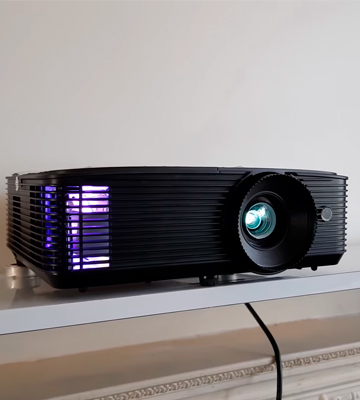


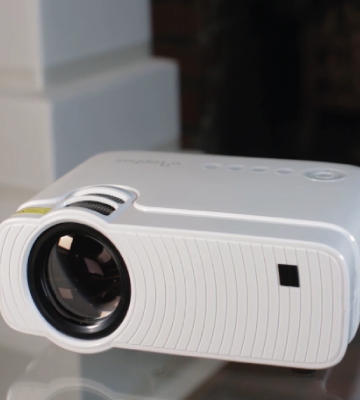
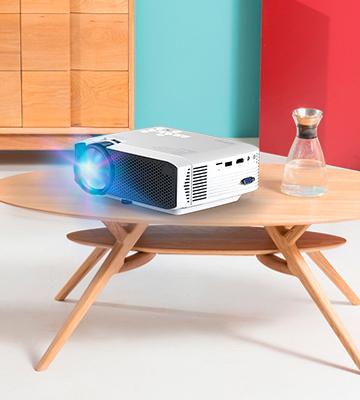
Your comment was successfully sent
Error! Please try again later